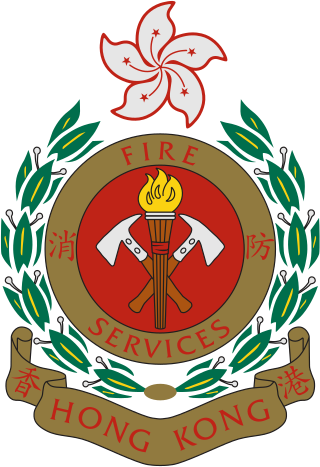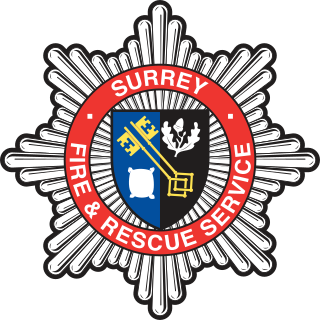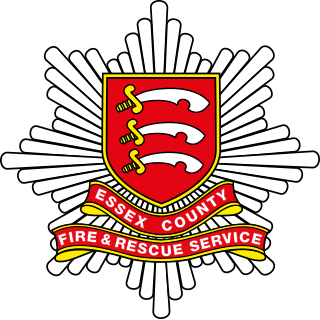
A fire engine or fire truck is a vehicle, usually a specially-designed or modified truck, that functions as a firefighting apparatus. The primary purposes of a fire engine include transporting firefighters and water to an incident as well as carrying equipment for firefighting operations in a fire drill. Some fire engines have specialized functions, such as wildfire suppression and aircraft rescue and firefighting, and may also carry equipment for technical rescue.

A water tender, sometimes known as a water tanker, is a type of firefighting apparatus that specializes in the transport of water from a water source to a fire scene. Water tenders are capable of drafting water from a stream, lake or hydrant.
Firefighting jargon includes a diverse lexicon of both common and idiosyncratic terms. One problem that exists in trying to create a list such as this is that much of the terminology used by a particular department is specifically defined in their particular standing operating procedures, such that two departments may have completely different terms for the same thing. For example, depending on whom one asks, a safety team may be referred to as a standby, a RIT or RIG or RIC, or a FAST. Furthermore, a department may change a definition within its SOP, such that one year it may be RIT, and the next RIG or RIC.
This is a glossary of firefighting equipment.

The Hong Kong Fire Services Department is an emergency service responsible for firefighting and rescue on land and sea. It also provides an emergency ambulance service for the sick and the injured and gives fire protection advice to the public. It is under the Secretary for Security who heads the Security Bureau.

The Singapore Civil Defence Force (SCDF) is a uniformed organisation in Singapore under the Ministry of Home Affairs that provides emergency services such as firefighting, technical rescue, and emergency medical services, and coordinates national civil defence programme.

Aircraft rescue and firefighting (ARFF) is a type of firefighting that involves the emergency response, mitigation, evacuation, and rescue of passengers and crew of aircraft involved in aviation accidents and incidents.

The London Fire Brigade (LFB) is the fire and rescue service for London, the capital of the United Kingdom. It was formed by the Metropolitan Fire Brigade Act 1865, under the leadership of superintendent Eyre Massey Shaw. It has 5,992 staff, including 5,096 operational firefighters and officers based at 102 fire stations.
The New Zealand Fire Service was New Zealand's main firefighting body from 1 April 1976 until 1 July 2017 – at which point it was dissolved and incorporated into the new Fire and Emergency New Zealand.

The Surrey Fire and Rescue Service is the statutory fire and rescue service for the County of Surrey, England, with 25 fire stations. It comes under the administrative and legislative control of Surrey County Council, acting as the fire authority who fund the service by collecting a precept via council tax, and from central government funds, known as a grant settlement, and provide the political leadership for the service.

Palm Beach County Fire Rescue (PBCFR) is one of the largest fire departments in the state of Florida. With 52 stations, Palm Beach County Fire Rescue provides fire protection, Advanced Life Support, emergency medical services, technical rescue, hazardous materials' mitigation, aircraft rescue/firefighting, fire investigation, and 911 dispatching for unincorporated parts of Palm Beach County, Florida as well as 19 cities under contract.
As firefighting has a rich history throughout the world, traditions in this profession vary widely from country to country.

An airport crash tender is a specialised fire engine designed for use in aircraft firefighting at aerodromes, airports, and military air bases.

The fire services in the United Kingdom operate under separate legislative and administrative arrangements in England and Wales, Northern Ireland, and Scotland.

The Israel Fire and Rescue Services is the national Israeli fire and rescue organization. The organisation also provides rescue services from terror attacks, car accident and dangerous substance spillages, along with Magen David Adom, the National EMS. They are also involved in public education and awareness campaigns. The service is accessed by calling 102 from any phone. As of 2022, the commissioner of the services is Eyal Casspi.

Essex County Fire and Rescue Service (ECFRS) is the statutory fire and rescue service for the county of Essex in the east of England, and is one of the largest fire services in the country, covering an area of 1,338 square miles (3,470 km2) and a population of over 1.7 million people.

Norfolk Fire and Rescue Service (NFRS) is the statutory fire and rescue service for the county of Norfolk in the east of England. The county consists of around 870,100 people, covering the 4th largest area in England with 2,074 square miles including 200 miles of inland waterways, 90 miles of coastline and 6,125 miles of roads. The county city is Norwich with other major towns including Great Yarmouth, King's Lynn and Thetford. Norfolk has one of the 20 Urban Search and Rescue teams across England and Wales which were set up in response to the 9/11 attacks. The teams, including Norfolk, have the capacity to deal with two simultaneous incidents across the UK.
Firefighting is the act of extinguishing destructive fires. A firefighter fights these fires with the intent to prevent destruction of life, property and the environment. Firefighting is a highly technical profession, which requires years of training and education in order to become proficient. A fire can rapidly spread and endanger many lives; however, with modern firefighting techniques, catastrophe can usually be avoided. To help prevent fires from starting, a firefighter's duties include public education and conducting fire inspections. Because firefighters are often the first responders to victims in critical conditions, firefighters often also provide basic life support as emergency medical technicians or advanced life support as licensed paramedics. Firefighters make up one of the major emergency services, along with the emergency medical service, the police, and many others.

Fire services in the United Kingdom use a variety of fire appliances, which perform a wide range of general and specialised roles and fit into several distinct categories. Contemporary fire appliances carry a multitude of equipment and firefighting media to deal with different types of emergencies ranging from fires, rescues, vehicle extrication, floods, salvage, casualty and trauma care.

Fire and Emergency New Zealand is New Zealand's main firefighting and emergency services body.

















